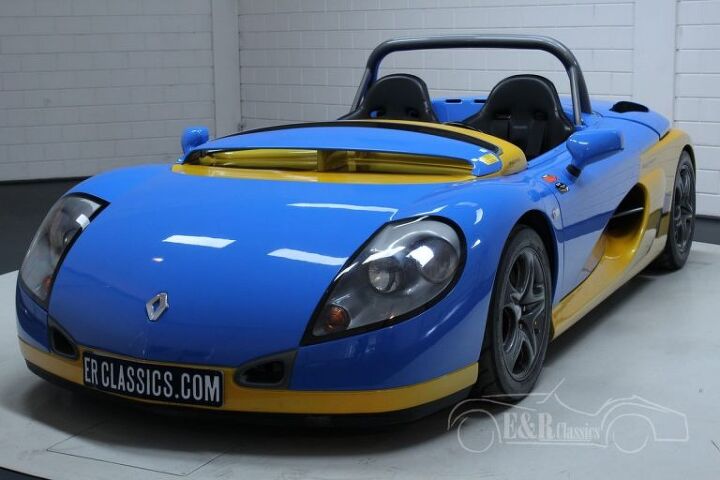Rare Rides: The 1997 Renault Sport Spider, Track Car for the Road

Today’s Rare Ride is equally at home on a track or on a road. Lightweight and minimalistic in its approach, the Renault Sport Spider has only the things you need to drive, and nothing else.
Let’s check out this bashful looking sports car.
Renault had a difficult time in the latter part of the Eighties. Financial troubles meant the company had to focus on core product, and not successors to more niche performance vehicles (like the R5 Turbo, for example). By the turn of the Nineties, Renault had restructured itself into a leaner and meaner state-owned company and sold off wet blanket AMC to Chrysler. It was time to bring back the excitement!
Subsidiary Renault Sport was tasked with the Projet de Création d’Excitation or whatever it was called and set to work. The new car was designed from the get-go as a racer and a road car. Renault created an aluminum chassis to make the car as light and strong as possible and then chose body panels made of plastic. The exterior looks were penned by Renault’s chief designer Patrick Le Quément, who also had a hand in the slightly important Ford Sierra, and the very successful Renault Twingo. Scissor doors were a flamboyant standard feature.
The engine and manual transmission of the Spider were a single unit, mounted transversely in the middle of the car. Inspired by airplane design, the package was fixed in an oscillating hinge. This feature eliminated engine vibration within the chassis. The engine itself was a 2.0-liter mill as used in the Clio Williams edition and made 148 horsepower and 129 lb-ft of torque. Not a huge power figure, but the Spider made up for it with a curb weight of just 2,050 pounds.
After a couple of years in development, a concept was shown to the public at Geneva in 1994. The Spider went on sale in 1996, shortly after it entered production. All Spiders were built by Alpine at their factory in Seine-Maritime and were the first car to wear a Renault Sport badge. Initially, there was no windscreen available, but a slim “aeroscreen” was created for the right-hand drive UK versions of the Spider, of which 100 were made. In 1997, a regular windscreen became available and was fitted with that utmost luxury: a wiper. Around 1,800 Spiders were made in total, and Renault also made a few racing examples that took part in the one-car Spider Championship. The Spider raced between 1995 and 1999 before it was retired, which was also the last year of standard Spider production.
Today’s Rare Ride is Sonic the Hedgehog blue and is one of the no windshield versions. Legal for import to Canada, the Spider asks $58,164 USD or $77,492 loonies.
[Images: seller]

Interested in lots of cars and their various historical contexts. Started writing articles for TTAC in late 2016, when my first posts were QOTDs. From there I started a few new series like Rare Rides, Buy/Drive/Burn, Abandoned History, and most recently Rare Rides Icons. Operating from a home base in Cincinnati, Ohio, a relative auto journalist dead zone. Many of my articles are prompted by something I'll see on social media that sparks my interest and causes me to research. Finding articles and information from the early days of the internet and beyond that covers the little details lost to time: trim packages, color and wheel choices, interior fabrics. Beyond those, I'm fascinated by automotive industry experiments, both failures and successes. Lately I've taken an interest in AI, and generating "what if" type images for car models long dead. Reincarnating a modern Toyota Paseo, Lincoln Mark IX, or Isuzu Trooper through a text prompt is fun. Fun to post them on Twitter too, and watch people overreact. To that end, the social media I use most is Twitter, @CoreyLewis86. I also contribute pieces for Forbes Wheels and Forbes Home.
More by Corey Lewis
Latest Car Reviews
Read moreLatest Product Reviews
Read moreRecent Comments
- 3-On-The-Tree My 2009 C6 corvette in black looks great when it’s all washed and waxed but after driving down my 1.3 mile long dirt road it’s a dust magnet. I like white because dust doesn’t how up easily. Both my current 2021 Tundra and previous 2014 Ford F-150 3.5L Ecobomb are white
- Bd2 Would be sweet on a Telluride.
- Luke42 When will they release a Gladiator 4xe?I don’t care what color it is, but I do care about being able to plug it in.
- Bd2 As I have posited here numerous times; the Hyundai Pony Coupe of 1974 was the most influential sports and, later on, supercar template. This Toyota is a prime example of Hyundai's primal influence upon the design industry. Just look at the years, 1976 > 1974, so the numbers bear Hyundai out and this Toyota is the copy.
- MaintenanceCosts Two of my four cars currently have tires that have remaining tread life but 2017 date codes. Time for a tire-stravaganza pretty soon.








































Comments
Join the conversation
I didn't even know these existed, but I'm super tempted to buy one now.
Gullwing doors? When these came out in the Lamborghini Countach they were called scissor doors. For gullwing doors, see the original Mercedes-Benz 300SL or the Delorean.